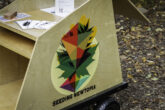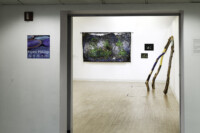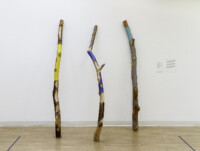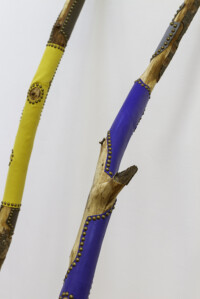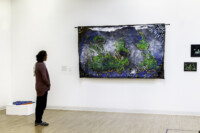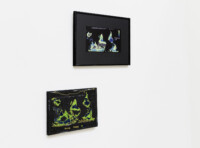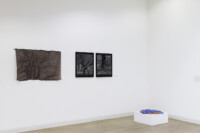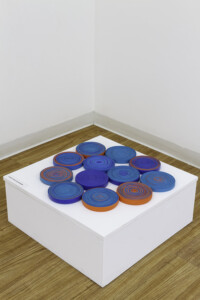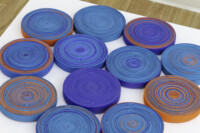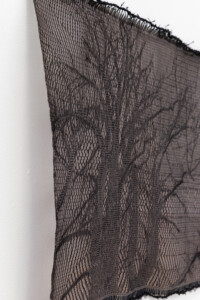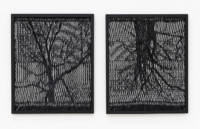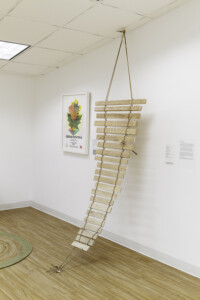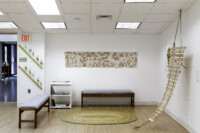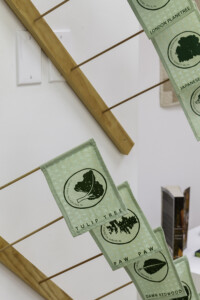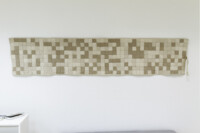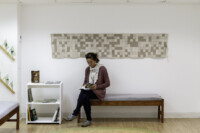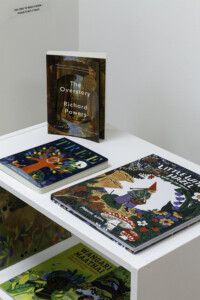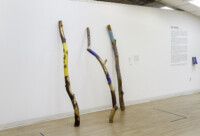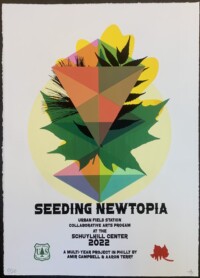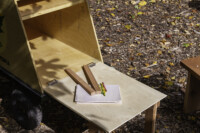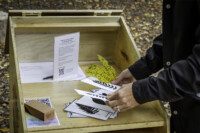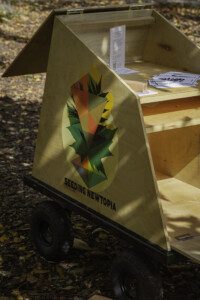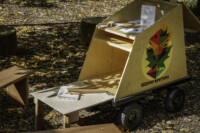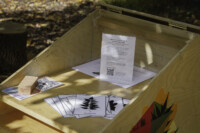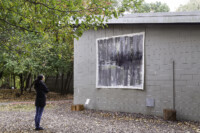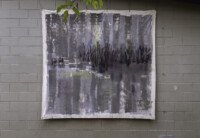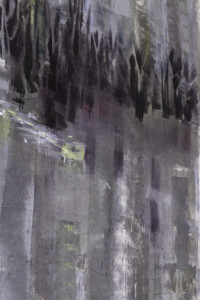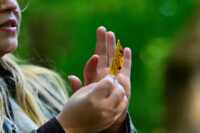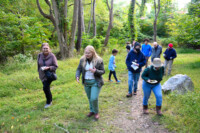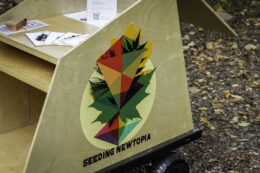Sept 24 – Dec 30, 2022
Curated by Tina Plokarz
Forest Makings is a group exhibition featuring sculptures, paintings, textiles and installations that explore how humans influence forests and manage their survival through practices of conservation. While shedding light on the environmental benefits of forests and the threats posed by changing climates, Forest Makings is an invitation to consider our own responsibility towards the health of forests and the survival of the earth.
Forest Makings presents artworks by Jean Shin, Ana Vizcarra Rankin, Aaron Terry, Amir Campbell, Tali Weinberg, Vivien Wise, and instrument makers Gladys Harlow, Richard Robinson, and Don Miller (as part of the art project S(tree)twork by Futurefarmers).
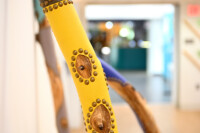
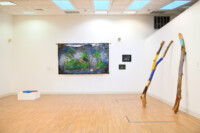
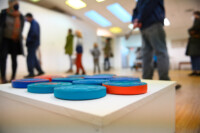
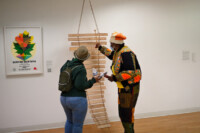
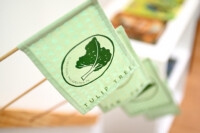
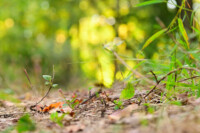
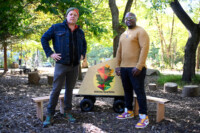
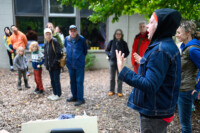
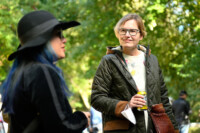
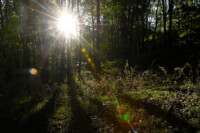

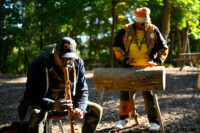
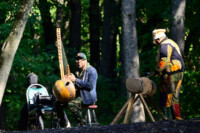
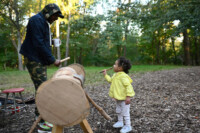
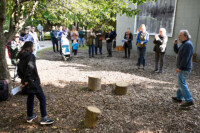
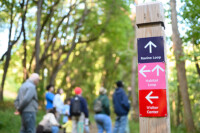
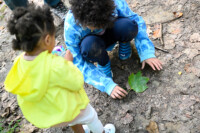
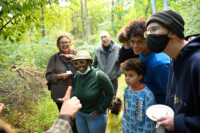
ABOUT THE PROJECT
Stewarding the forest for the benefit of humans and the forest ecosystem is best practice at the Schuylkill Center. Through careful management and strategic planning, the landscape has been transformed from an exhausted farm to a forested gem that is dear to the public yet also threatened by climatic and habitat changes. Recognizing the importance of forests as solutions to rising temperatures, air pollution, and habitat and biodiversity loss, the exhibition Forest Makings takes the Schuylkill Center’s landscape as a starting point for bringing forests and their protagonists, trees, into focus. Without making any claim to comprehensiveness, the exhibition offers a glimpse into a wide range of conservation strategies – from reforestation to natural regeneration to controlled burns – and into our emotional connection to nature.
Forests today are in crisis: converted for agriculture, fuel and timber, depleted by fire and mistreated by an economy that extracts natural resources while putting biodiversity and ecosystems at risk and affecting the livelihood and wellbeing of local communities. Commercial agriculture and monocultural tree plantations feed our ever-growing population and desire for economic growth but also result in deforestation. Even though deforestation has existed since the earliest human civilizations, forest loss has exploded since the advent of industrialization, leaving only a shrinking third of the earth covered with arboreal habitats. At the same time our connection to and understanding of trees and forests has also diminished.
The artworks in this exhibition call attention to our connectedness to trees and how we can care for them into the future. S.O.S. by Jean Shin exemplifies the ferocious history of commercial logging of Hemlock trees for leather-making in the early 19th century. The tanbark industry diminished this species significantly, resulting in groundwater pollution and increasing vulnerability to soil erosion. International, national and local control mechanisms and management initiatives were launched to counteract the depletion of forests.
Today, movements such as the Trillion Tree Campaign aim to turn the tides of forest loss. Their intention is to make worldwide reforestation and afforestation a socio-economic imperative that not only restores landscapes adapting to climatic change but also attaches monetary and legal values to trees. Forest Futures Growth by Ana Vizcarra Rankin visualizes the global potential tree cover that would be required to counterbalance our current carbon footprint. What might the world look like if forest ecosystems are not only respected for the sake of human survival but also for nature in its own right?
As we see forests diminish, Memories of Future Fires and Tree Rings by Tali Weinberg asks us to consider our symbiotic relationship with trees and their roles in ecosystem health, climate mitigation, and carbon sequestration. When well-chosen, the controlled application of fire can help restore ecosystem health. But with the continuous encroachment of human activity and urbanization into forested land, its management has become more restricted, turning our relationship to trees and forests into a complicated and risky balancing act.
The field recordings Seeding Newtopia by Aaron Terry and Amir Campbell, in partnership with the U.S. Forest Service, are in search of our relationship with the natural world as expressed through our personal memories and feelings about trees. By collecting tree stories in our communities, the artists underscore that trees are connected, communicative and co-dependent members of diverse communities.
The reciprocal altruism of trees and their care for the environment and each other also permeates Walnut Tree Quilt by Vivien Wise and the instruments by Gladys Harlow, Richard Robinson, and Don Miller, made from fallen trees in Germantown, Philadelphia, as part of the tree awareness project S(tree)twork by Futurefarmers. The quilt and the instrument call on us to practice the same kind of restorative care in our own relations to forests and to the environment.
Seeding Newtopia — a collaborative sound project between artists Aaron Terry and Amir Campbell in partnership with the USDA Forest Service (Philadelphia Field Station) — for more information please visit: www.aaroneliahterry.com
If you want to become part of a larger scientific field study, simply your tree story online via this LINK.
ABOUT THE ARTISTS
Korean-American artist Jean Shin is known for her large-scale installations and public sculptures of discarded objects that interrogate our complex relationship between material consumption, collective identity and community engagement. Shin amasses vast collections of an everyday object or material—Mountain Dew soda bottles, mobile phones, 35mm slides—while researching its history of use, circulation and environmental impact. Distinguished by her labor-intensive and participatory process, Shin’s poetic yet epic creations become catalysts for communities to confront social and ecological challenges. She is a tenured Adjunct Professor at Pratt Institute and holds an honorary doctorate from New York Academy of Art. Shin’s work has been widely exhibited and collected in over 150 major museums and cultural institutions, including solo exhibitions at The Museum of Modern Art in New York, Philadelphia Museum of Art, Smithsonian American Art Museum in Washington DC, and Asian Art Museum in San Francisco. Shin has received numerous awards, including the forthcoming Frederic Church Award for her contributions to American art and culture. www.jeanshin.com
Aaron Terry‘s work dances between sculptural, sonic and printed materials that present visual allegories of personal politics embedded in the color, flash and cadence of today’s rapid-fire media parade. Appropriated and collaged content recalls, recasts and invokes history, while presenting a shared negotiation of memory. Sourcing from sound bites, cultural archives, and news media, his work synthesizes sonic and visual elements of pop culture, politics and propaganda to reinvigorate progressive ideas that have diminished through false familiarity over time and to challenge the role of art in today’s political climate. Terry holds an MFA from the San Francisco Art Institute. He currently is an Assistant Professor of Art and Design (Printmaking) at the University of Delaware. www.aaroneliahterry.com
Amir Campbell, also known as Amiracle, is a multi-faceted creative. His paintings, videos and installations revolve around displaced identity and unity through the lens of integration and assimilation into American Culture as an African American. Through his work, he communicates and forms relationships with his audience. Amiracle uses his subject matter to advance the opportunity to introduce them to the world of artistic expression and explain his views with a sincere hope to reach all who can connect with unity, oneness, and the perspective of exciting hope. His ultimate vision is to blend the worlds of fine art with street art. www.amiraclearts.com
Gladys Harlow, Richard Robinson, and Don Miller are the drum and xylophone makers behind the sound portion of the S(Tree)twork project. Their displayed instruments are part of A Summoning in the Intra-Galactic Forest by S(tree)twork, a multi-year, public art project in collaboration with lead artist Futurefarmers. S(tree)twork aims to animate how we live among trees; how we perceive them; and how we imagine our future co-habitation while connecting Philadelphia with a growing presence of forest tenders. The artists credited are instrumental in creation but we would like to acknowledge all those that help mold this project. https://streetworkproject.net/intra-galactic-forest/
Ana Vizcarra Rankin is a Uruguayan-American artist based in Philadelphia. In large-scale paintings and hand-crafted collages of world maps and astronomical constellations, Vizcarra Rankin investigates themes of space, time, and scientific exploration. Her works function like cartograms of environments that unravel correlations between humanity, globalization, migration and living species on our planet. Rankin’s work is held in several public collections, and has been featured in solo exhibitions at locations including The Brandywine River Museum of Art, Cherry Street Pier, Instituto Cervantes of Chicago, and the Embassy of Uruguay in Washington DC. She holds an MFA from the Pennsylvania Academy of the Fine Arts. https://linktr.ee/avrankin
Tali Weinberg interweaves petrochemical- and plant-derived materials, data, and landscape imagery to draw connections between climate crisis, fossil fuel extraction, and the buildup of harmful plastics in our bodies and ecosystems. Her newest weavings and sculptures explore the life-sustaining circulatory systems that are both internal and external to the human body—from lungs and arteries to forests and watersheds. Transforming medical waste into tree rings, and weaving trees out of plastic into forms that reference anatomy, Tali’s work traces relationships between personal and communal loss, and between corporeal and ecological bodies. She has exhibited internationally from California to Australia and is currently a 2022 Illinois Artist Fellow. www.taliweinberg.com
Vivien Wise is a multimedia artist, quilter and designer based in Philadelphia. Her textiles, installations and performances center around the social structure of art as a tool for connecting humanity to the natural environment, intertwining materiality, community and environmental activism. She holds an MFA in Fibers and Material Studies from the Tyler School of Art. www.vivienwise.com
PAST EVENTS
Saturday, October 8 | 3:30 pm–5:30 pm | Art Opening Forest Makings
With music by instrument makers Rich Robinson and Karen Smith; a tree ID hike with educator and land steward Sam Bucciarelli, as well as light food and refreshment under the forest’s canopy.
ABOUT OUR SUPPORTERS
Generous support for this project and the Schuylkill Center’s environmental art program has been provided by the Pennsylvania Council on the Arts, the National Wildlife Federation for event programming as part of The Alliance for Watershed Education (AWE) and private donations by our members, supporters and friends.
Consider making a gift to the Environmental Art Program in support of our ongoing art program, and help build curiosity and community in Philadelphia. SUPPORT the Environmental Art Department

